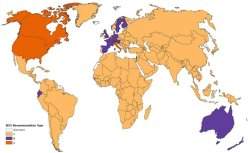* REVIEW ARTICLES
Conditions affecting growth and developmental competence of mammalian oocytes in vitro (pages 187–197)
Yuji HIRAO
Article first published online: 24 MAR 2011 | DOI: 10.1111/j.1740-0929.2010.00870.x
Metabolism of microbial nitrogen in ruminants with special reference to nucleic acids (pages 198–208)
Tsutomu FUJIHARA and Martin N. SHEM
Article first published online: 24 MAR 2011 | DOI: 10.1111/j.1740-0929.2010.00871.x
* ORIGINAL ARTICLES
A proximal genomic region of mouse chromosome 10 contains quantitative trait loci affecting fatness (pages 209–214)
Akira ISHIKAWA, Takahisa TANAHASHI and Hiroyuki KODAMA
Article first published online: 4 MAR 2011 | DOI: 10.1111/j.1740-0929.2010.00842.x
Establishment and characterization of a fibroblast cell line derived from Mongolian sheep (pages 215–222)
Chang‐Qing LIU, Yu GUO, Wei‐Jun GUAN and Yue‐Hui MA
Article first published online: 23 FEB 2011 | DOI: 10.1111/j.1740-0929.2010.00824.x
Allele‐specific PCR typing and sequencing of the mitochondrial D‐loop region in four layer breeds (pages 223–226)
Takashi HARUMI, Akiko SANO, Takeo MINEMATSU and Mitsuru NAITO
Article first published online: 2 MAR 2011 | DOI: 10.1111/j.1740-0929.2010.00831.x
Oocytic expression of zona pellucida protein ZP4 in Japanese quail (Coturnix japonica) (pages 227–235)
Mami SERIZAWA, Mihoko KINOSHITA, Daniela RODLER, Akira TSUKADA, Hiroko ONO, Takashi YOSHIMURA, Norio KANSAKU and Tomohiro SASANAMI
Article first published online: 23 FEB 2011 | DOI: 10.1111/j.1740-0929.2010.00830.x
Constant transmission of mitochondrial DNA in intergeneric cloned embryos reconstructed from swamp buffalo fibroblasts and bovine ooplasm (pages 236–243)
Kanokwan SRIRATTANA, Kazutsugu MATSUKAWA, Satoshi AKAGI, Mariko TASAI, Takahiro TAGAMI, Keijiro NIRASAWA, Takashi NAGAI, Yukio KANAI, Rangsun PARNPAI and Kumiko TAKEDA
Article first published online: 23 FEB 2011 | DOI: 10.1111/j.1740-0929.2010.00827.x
Contribution of hypoxia‐inducible factor‐1[GREEK SMALL LETTER ALPHA] to transcriptional regulation of vascular endothelial growth factor in bovine developing luteal cells (pages 244–250)
Zhenghong ZHANG, Dingzhong YIN and Zhengchao WANG
Article first published online: 24 FEB 2011 | DOI: 10.1111/j.1740-0929.2010.00832.x
Observations on hand‐mating behaviors, several physiological and hematological parameters in Turkish dairy goats (pages 251–258)
Aynur KONYALI, Cemil TÖLÜ, Bekir Sıtkı AYAĞ and Hande Işıl AKBAĞ
Article first published online: 6 MAR 2011 | DOI: 10.1111/j.1740-0929.2010.00851.x
Fermentation characteristics and microorganism composition of total mixed ration silage with local food by‐products in different seasons (pages 259–266)
Yang CAO, Yimin CAI, Tomomi HIRAKUBO, Hiroyuki FUKUI and Hiroki MATSUYAMA
Article first published online: 2 MAR 2011 | DOI: 10.1111/j.1740-0929.2010.00840.x
Effects of amino acids infused into the vein on ghrelin‐induced GH, insulin and glucagon secretion in lactating cows (pages 267–273)
Rika FUKUMORI, Akinori YOKOTANI, Toshihisa SUGINO, Fumiaki ITOH, Shiro KUSHIBIKI, Hiroyuki SHINGU, Naoko MORIYA, Yoshihisa HASEGAWA, Masayasu KOJIMA, Kenji KANGAWA, Taketo OBITSU and Kohzo TANIGUCHI
Article first published online: 2 MAR 2011 | DOI: 10.1111/j.1740-0929.2010.00838.x
Effect of dietary addition of seaweed and licorice on the immune performance of pigs (pages 274–281)
Masafumi KATAYAMA, Tomokazu FUKUDA, Toshihiro OKAMURA, Eisaku SUZUKI, Katsuo TAMURA, Yuuko SHIMIZU, Yoshihito SUDA and Keiichi SUZUKI
Article first published online: 22 DEC 2010 | DOI: 10.1111/j.1740-0929.2010.00826.x
Efficacy of probiotics from anaerobic microflora with prebiotics on growth performance and noxious gas emission in growing pigs (pages 282–290)
Gyo Moon CHU, Shin Ja LEE, Ho Sik JEONG and Sung Sill LEE
Article first published online: 23 FEB 2011 | DOI: 10.1111/j.1740-0929.2010.00828.x
Tissue distribution of albumin‐glucose advanced glycation end products administrated to chickens (pages 291–295)
Kazumi KITA
Article first published online: 24 FEB 2011 | DOI: 10.1111/j.1740-0929.2010.00837.x
Effect of indigestible sugars on nitrogen utilization in adult rabbits (pages 296–301)
Xiao LI, Xiao MIN, Yuta TSUZUKI and Ei SAKAGUCHI
Article first published online: 4 MAR 2011 | DOI: 10.1111/j.1740-0929.2010.00849.x
Evaluation of the heat‐killed and dried cell preparation of Enterococcus faecalis against villous atrophy in early‐weaned mice and pigs (pages 302–306)
Takamitsu TSUKAHARA, Yoko YOSHIDA, Toshiki TSUSHIMA, Takumi WATANABE, Noritaka MATSUBARA, Ryo INOUE and Kazunari USHIDA
Article first published online: 23 FEB 2011 | DOI: 10.1111/j.1740-0929.2010.00829.x
Immunohistochemical and ultrastructural characterization of the ovarian surface epithelium of Japanese quail (Coturnix japonica) (pages 307–313)
Daniela RODLER and Fred SINOWATZ
Article first published online: 4 MAR 2011 | DOI: 10.1111/j.1740-0929.2010.00843.x
Effect of intracerebroventricular injections of prolactin‐releasing peptide on prolactin release and stress‐related responses in steers (pages 314–319)
Sayuki KITAGAWA, Naoshige ABE, Madoka SUTOH, Etsuko KASUYA, Shoei SUGITA, Masato AOYAMA and Ken‐ichi YAYOU
Article first published online: 4 MAR 2011 | DOI: 10.1111/j.1740-0929.2010.00841.x
Changes in oxidative status in periparturient dairy cows in hot conditions (pages 320–324)
Masahito TANAKA, Yuko KAMIYA, Tomoyuki SUZUKI and Yutaka NAKAI
Article first published online: 24 FEB 2011 | DOI: 10.1111/j.1740-0929.2010.00839.x
Japanese consumer categorisation of beef into quality grades, based on Meat Standards Australia methodology (pages 325–333)
Rod J. POLKINGHORNE, Takanori NISHIMURA, Kate E. NEATH and Ray WATSON
Article first published online: 23 FEB 2011 | DOI: 10.1111/j.1740-0929.2010.00825.x
Investigation into the durability of washed rice straw for equine bedding and the repetitive use of washing water (pages 334–339)
Akira KUROSAWA, Daisuke ENDO, Shuhei IKEDA and Seizi SUKEMORI
Article first published online: 23 FEB 2011 | DOI: 10.1111/j.1740-0929.2010.00822.x
Characterization and partial purification of a bacteriocin‐like substance produced by thermophilic Bacillus licheniformis H1 isolated from cow manure compost (pages 340–351)
Hosnia S ABDEL‐MOHSEIN, Takako SASAKI, Chika TADA and Yutaka NAKAI
Article first published online: 2 MAR 2011 | DOI: 10.1111/j.1740-0929.2010.00835.x
Comparison of feeding systems: feed cost, palatability and environmental impact among hay‐fattened beef, consistent grass‐only‐fed beef and conventional marbled beef in Wagyu (Japanese Black cattle) (pages 352–359)
Khounsaknalath SITHYPHONE, Mitsuyasu YABE, Hiroshi HORITA, Keisuke HAYASHI, Tomiko FUMITA, Yuji SHIOTSUKA, Tetsuji ETOH, Fumio EBARA, Olavanh SAMADMANIVONG, Jochen WEGNER and Takafumi GOTOH
Article first published online: 24 FEB 2011 | DOI: 10.1111/j.1740-0929.2010.00836.x
* RAPID COMMUNICATION
Survival of embryos and calves derived from somatic cell nuclear transfer in cattle: a nationwide survey in Japan (pages 360–365)
Shinya WATANABE and Takashi NAGAI
Article first published online: 4 MAR 2011 | DOI: 10.1111/j.1740-0929.2010.00846.x
1740-0929/asset/olbannerleft.jpg?v=1&s=ff5434daacfe87a8592e550ebdb1076223ead507)


2045-0648/asset/olbannerleft.jpg?v=1&s=2a9135491610b32e415f6d0b1dc4940bcc95bc06)





